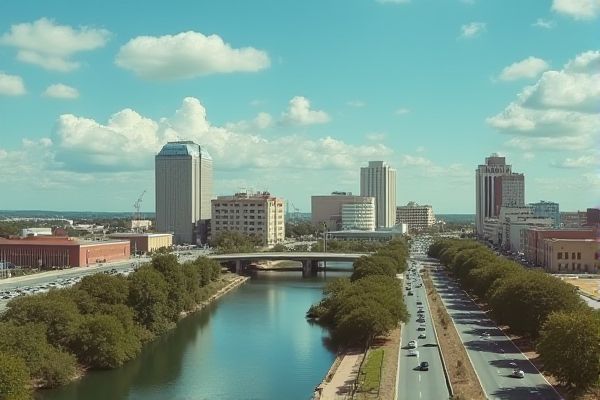
Moving to Oklahoma checklist: Research cost of living. Explore housing options. Understand local weather patterns. Familiarize with state taxes. Register your vehicle. Transfer driver's license. Choose a reliable moving company. Find local healthcare providers. Enroll children in schools. Discover local cultural attractions.
Research cost of living.
The cost of living in Oklahoma City, OK is notably affordable, being 15% lower than the national average. One of the most significant factors contributing to this affordability is housing, which is 32% cheaper compared to many parts of the country. In addition, utilities are 4% lower, offering residents further economic relief. Essential expenses such as food, healthcare, and goods & services are also significantly lower than the national averages. For more detailed information on the cost of living in this vibrant city, you can visit the Cost of Living Calculator provided by RentCafe.
Explore housing options.
For those moving to Oklahoma, especially students, Oklahoma State University offers a variety of detailed housing options, including undergraduate, family and graduate student housing, and summer conference housing, each with features like housing styles, pricing, and location. If you're looking for more permanent accommodations in the state, Zillow provides a comprehensive search for homes for sale in Oklahoma, offering listing photos, sales history, and real estate filters to find the perfect place across various locations and property details. Additionally, Homestead Realty Co serves as a one-stop source for Oklahoma real estate, allowing users to search via an interactive map, explore community guides, and set up email notifications for new listings that meet their specific criteria.
Understand local weather patterns.
Oklahoma's climate varies from humid subtropical in the east to semi-arid in the west, with warm, moist air from the Gulf of Mexico influencing the south and east. The state experiences hot summers, mild winters, and significant precipitation variability, with the east receiving more rainfall and the west experiencing more extreme summer temperatures and droughts. For more detailed information about the climate in Oklahoma, you can visit the Oklahoma Climate Survey website.
Familiarize with state taxes.
To familiarize yourself with Oklahoma State Taxes, you need to understand the filing requirements, types of taxable income, and available exemptions. Residents, part-year residents, and nonresidents have different filing obligations, and income from various sources such as salaries, business activities, and property located in Oklahoma is subject to state tax. For more detailed information, visit the Oklahoma Tax Commission website, which provides resources and guidance specific to state tax obligations.
Register your vehicle.
To register your vehicle in Oklahoma, gather required documents such as the Application for Oklahoma Certificate of Title (Form 701-6), proof of ownership, Oklahoma car insurance, and lien documentation if applicable. Visit a Motor License Agent office, submit the documents, and pay the necessary fees, which include title, registration, and potential VIN inspection fees. For an in-depth understanding of each step involved in this process, you can refer to the Ultimate Guide to Registering Your Vehicle in Oklahoma.
Transfer driver's license.
If you have recently moved to Oklahoma and are planning to transfer your out-of-state driver's license, it's important to know that you must do so in person. You will need to surrender your valid or recently expired out-of-state license and provide primary and secondary ID documents along with proof of legal presence. Additionally, you'll be required to pass a vision test, present your social security card, and provide any documents proving a legal name change if applicable. For more detailed information on the process, you can visit DMVCheatSheets.
Choose a reliable moving company.
When selecting a reliable moving company, it's essential to obtain a written estimate and confirm that the mover is authorized and insured with a U.S. DOT number. Additionally, checking their complaint history can provide insight into their reputation. While it's tempting to prioritize the lowest price, it's crucial to focus on your specific needs. Conducting thorough research using resources such as the FMCSA Search Tool and consumer protection agencies can further guide you in making an informed decision.
Find local healthcare providers.
To find local healthcare providers in Oklahoma, use the SoonerCare Provider Directory to search by plan, provider name, facility, specialty, state, and city. This ensures the provider is contracted with SoonerCare or SoonerSelect, helping you avoid out-of-network charges.
Enroll children in schools.
To enroll children in Oklahoma schools, you must complete online or in-person enrollment, providing documents such as proof of address, immunization records, birth verification, and current custody documentation if applicable. Specific age requirements and additional forms like previous school transcripts may also be necessary. For more comprehensive details, visit the Enrollment Back to School page, where you can find all necessary information and guidelines for the 2024-2025 enrollment process.
Discover local cultural attractions.
Discover local cultural attractions in Green Country Oklahoma, including powwows, museums, and historic sites that showcase Native American heritage, Old West history, and vibrant cities with Art Deco architecture and performing arts. Explore Oklahoma's diverse past through the Oklahoma Historical Society's museums, historic homes, and military sites, such as the Oklahoma History Center, Fort Gibson Historic Site, and the Will Rogers Memorial Museum. Visit the First Americans Museum in Oklahoma City to experience the collective histories of First American Nations, featuring state-of-the-art exhibitions, community events, and Indigenous-inspired cuisine.
